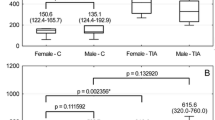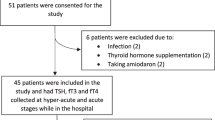Abstract
Altered hypothalamo-pituitary-adrenal axis was reported in stroke patients; however, mechanisms responsible for this phenomenon are barely understood. Acute cerebral ischemia triggers interleukin-6 (IL-6) release into blood. Circulating IL-6 can stimulate hypothalamo-pituitary-adrenal axis. The goal of our study was to assess a relationship between serum IL-6 and cortisol in acute ischemic stroke. Twenty two patients with ischemic stroke and 17 controls were included. Serum samples were collected on the 2nd day of stroke at 6:00, 10:00 18:00, 22:00 h and at the same time points in control group. Cytokines and cortisol levels were measured using ELISA method. Serum IL-6 and cortisol levels were higher in stroke patients than in controls. Cortisol displayed diurnal variations in both stroke patients and controls. In contrast with control subjects, serum IL-6 levels did not display diurnal variations in stroke patients. In stroke patients, but not in controls, IL-6 level correlated significantly with cortisol level and morning serum IL-6 level independently predicted evening/night cortisol level. In conclusion, brain ischemia could stimulate IL-6 release in blood and in this way modulate hypothalamo-pituitary-adrenal axis.
Similar content being viewed by others
References
Olsson T. Urinary free cortisol excretion shortly after ischaemic stroke. J Intern Med 1990, 228: 177–81.
Olsson T, Astrom M, Eriksson S, et al. Hypercortisolism revealed by the dexamethasone suppression test in patients with acute ischemic stroke. Stroke 1989, 20: 1685–90.
Olsson T, Marklund N, Gustafson Y, et al. Abnormalities at different levels of the hypothalamic-pituitary-adrenocortical axis early after stroke. Stroke 1992, 23: 1573–6.
Murros K, Fogelholm R, Kettunen S, et al. Serum cortisol and outcome of ischemic brain infarction. J Neurol Sci 1993, 16: 12–7.
Fassbender K, Schmidt R, Moessner R, et al. Pattern of activation of the hypothalamic-pituitary-adrenal axis in acute stroke. Relation to acute confusional state, extent of brain damage and clinical outcome. Stroke 1994, 25: 1105–8.
Franceschini R, Gandolfo C, Cataldia A, et al. Twenty-four-hour β-endorphin secretory pattern in stroke patients. Stroke 1994, 25: 2142–5.
Slowik A, Turaj W, Pankiewicz J, et al. Hypercortisolemia in acute stroke is related to the inflammatory response. J Neurol Sci 2002, 196: 27–32.
Turnbull AV, Rivier C. Regulation of the HPA axis by cytokines. Brain Behav Immun 1995, 9: 253–75.
Gaillard RC. Interaction between the hypothalamo-pituitary-adrenal axis and the immunological system. Ann Endocrinol (Paris) 2001, 62: 155–63.
Brott T, Marler JR, Olinger CP, et al. Measurements of acute cerebral infarction: lesion size by computed tompgraphy. Stroke 1989, 20: 871–5.
Adams HP, Bendixen BH, Kappelle LJ, and the TOAST investigators. Classification of subtype of acute ischemic stroke: definitions for use in a multicenter clinical trial. Stroke 1993, 24: 35–41.
Gustafson Y, Olsson T, Asplund K, et al. Acute confusional states early after stroke is associated with hypercortisolism. Cerebrovasc Dis 1993, 3: 33–8.
Astrom M, Olsson T, Asplund K. Different linkage of major depression to hypercortisolism early versus late after stroke: results from a 3-year longitudinal study. Stroke 1993, 24: 52–7.
Oka M. Effect of cerebrovascular accident on the level of 17-hydroxycorticosteroids in plasma. Acta Med Scand 1956, 154: 221–6.
O’Neill PA, Davies I, Fullerton KJ, et al. Stress hormone and blood glucose response following acute stroke in the elderly. Stroke 1991, 22: 842–7.
Haack M, Reichenberg A, Kraus T, et al. Effects of an intravenous catheter on the local production of cytokines and soluble cytokine receptors in healthy men. Cytokine 2000, 12: 694–8.
Ikonomidis I, Andreotti F, Economou E, et al. Increased proinflammatory cytokines in patients with chronic stable angina and their reduction by aspirin. Circulation 1999, 100: 793–8.
Tarkowski E, Rosengren L, Blomstrand C, et al. Early intrathecal production of interleukin-6 predicts the size of brain lesion in stroke. Stroke 1995, 26: 1393–8.
Fassbender K, Rossol S, Kammer T, et al. Proinflammatory cytokines in serum of patients with acute cerebral ischemia: kinetics of secretion and relation to the extent of brain damage and outcome of disease. J Neurol Sci 1994, 122: 135–9.
Beamer NB, Coull BM, Clark WM, et al. Interleukin-6 and interleukin-1 receptor antagonist in acute stroke. Ann Neurol 1995, 37: 800–4.
Kim JS, Yoon SS, Kim YH, et al. Serial measurement of interleukin-6, transforming growth factor-β, and S-100 protein in patients with acute stroke. Stroke 1996, 27: 1553–7.
Ferrarese C, Mascarucci P, Zoia C, et al. Increased cytokine release from peripheral blood cells after acute stroke. J Cereb Blood Flow Metab 1999, 19: 1004–9.
Perini VF, Morra M, Alecci M, et al. Temporal profile of serum anti-inflammatory and pro-inflammatory interleukins in acute ischemic stroke patients. Neurol Sci 2001, 22: 289–96.
Sothern RB, Roitman-Johnson B, Kanabrocki EL et al. Circadian characteristics of circulating interleukin-6 in men. J Allergy Clin Immunol 1995, 95: 1029–35.
Mastorakos G, Chrousos GP, Weber JS. Recombinant interleukin-6 activates the hypothalamic-pituitary-adrenal axis in humans. J Clin Endocrinol Metab 1993, 77: 1690–4.
Spath-Schwalbe E, Born J, Schrezenmeier H, et al. Interleukin-6 stimulates the hypothalamus-pituitary-adrenocortical axis in man. J Clin Endocrinol Metab 1994, 79: 1212–4.
Judd AM, Call GB, Barney M, et al. Possible function of IL-6 and TNF as intraadrenal factors in the regulation of adrenal steroid secretion. Ann NY Acad Sci 2000, 917: 628–37.
Johansson A, Olsson T, Carlberg B, et al. Hypercortisolism after stroke — partly cytokine mediated? J Neurol Sci 1997, 147: 43–7.
Johansson A, Ahren B, Nasman B, et al. Cortisol axis abnormalities early after stroke — relationship to cytokines and leptin. J Inter Med 2000, 247: 179–87.
De Rijk R, Michelson D, Karp B, et al. Exercise and circadian rhythm-induced variations in plasma cortisol differentially regulate interleukin-1 beta (IL-1 beta), IL-6, and tumor necrosis factor-alpha (TNF alpha) production in humans: high sensitivity of TNF alpha and resistance of IL-6. J Clin Endocrinol Metab 1997, 82: 2182–91.
Elneihoum AM, Falke P, Axelsson L, et al. Leukocyte activation detected by increased plasma levels of inflammatory mediators in patients with ischemic cerebrovascular diseases. Stroke 1996, 27: 1734–8.
Author information
Authors and Affiliations
Rights and permissions
About this article
Cite this article
Szczudlik, A., Dziedzic, T., Bartus, S. et al. Serum interleukin-6 predicts cortisol release in acute stroke patients. J Endocrinol Invest 27, 37–41 (2004). https://doi.org/10.1007/BF03350908
Accepted:
Published:
Issue Date:
DOI: https://doi.org/10.1007/BF03350908




